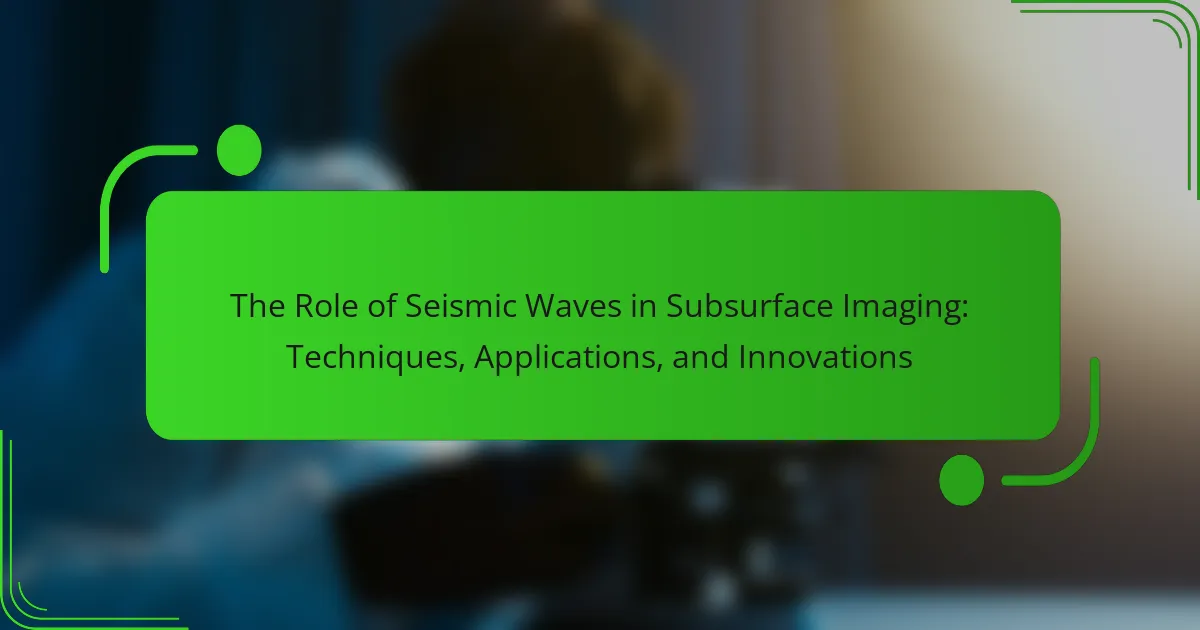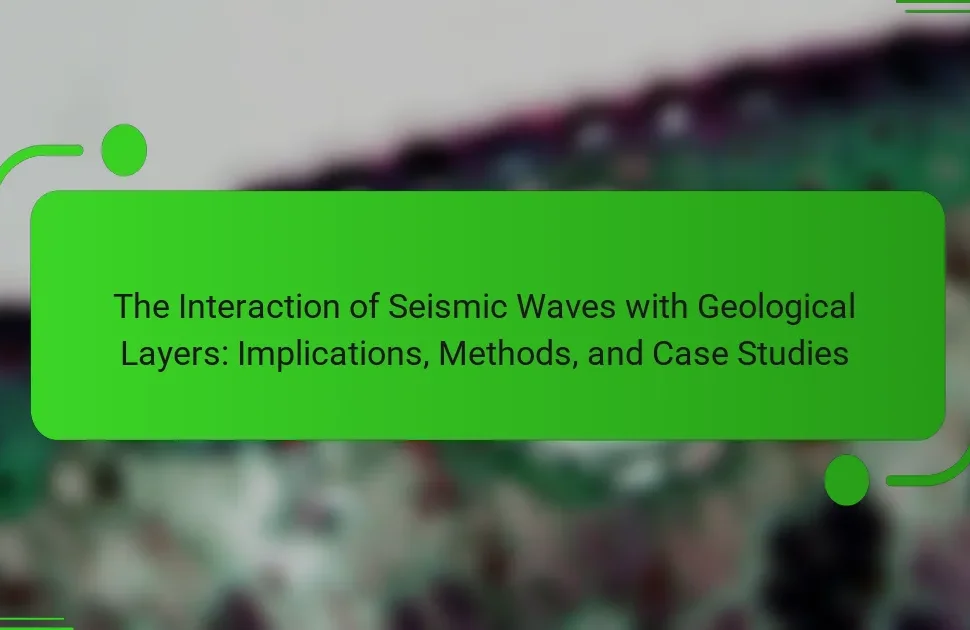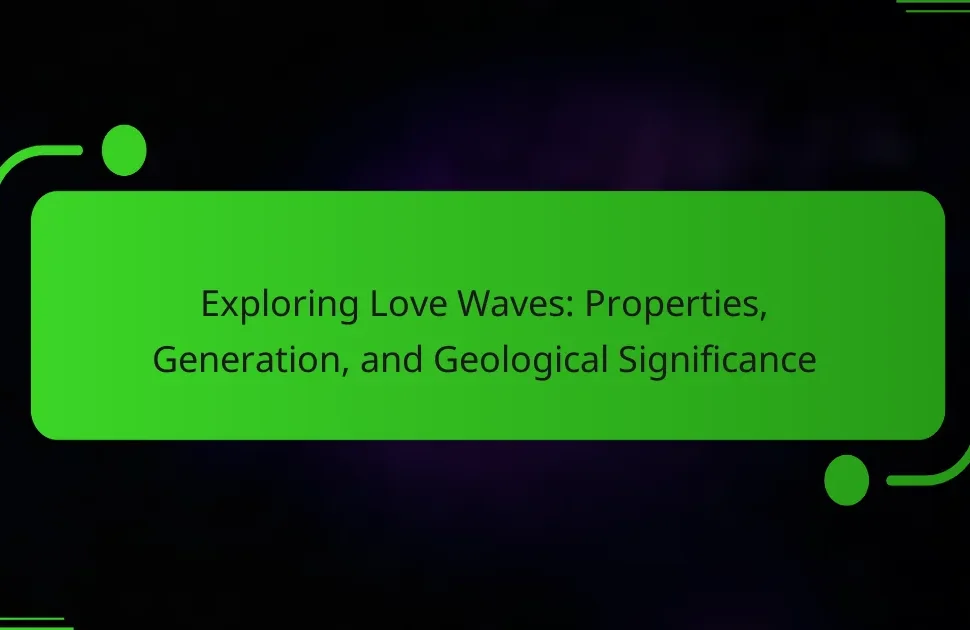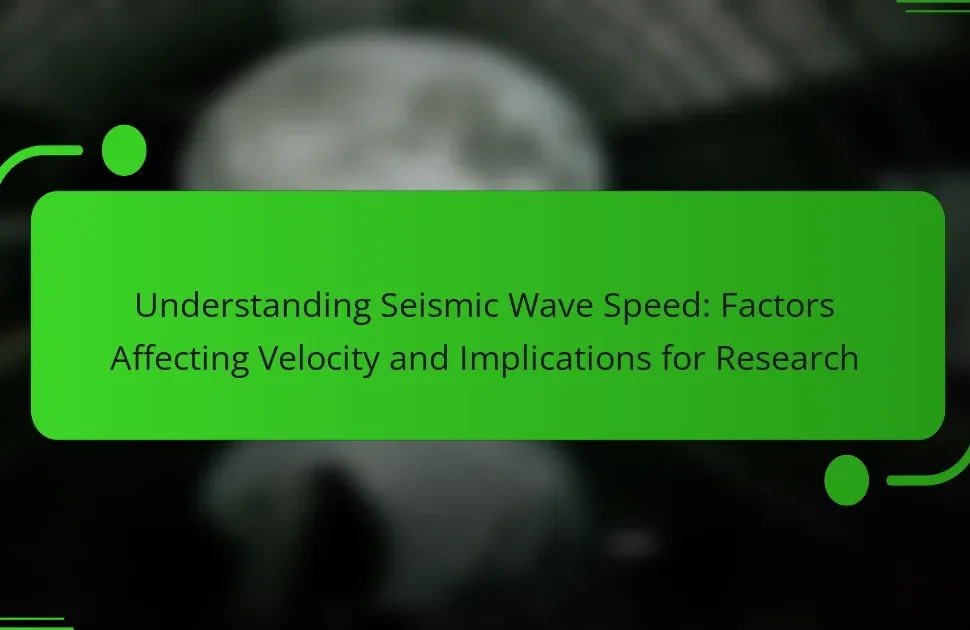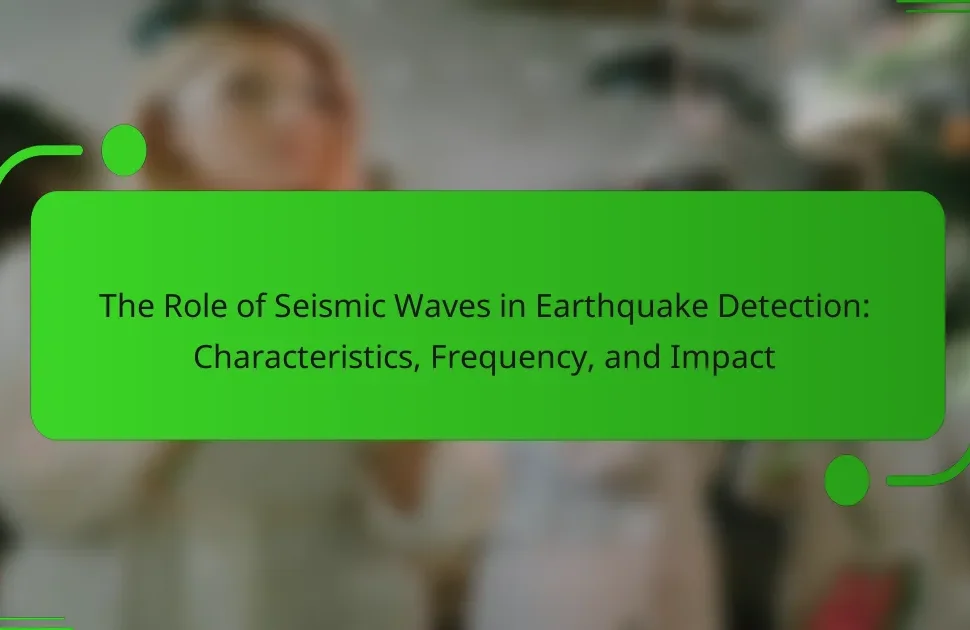Seismic waves are elastic waves produced by the sudden release of energy in the Earth’s crust, classified into body waves (P-waves and S-waves) and surface waves. These waves play a crucial role in subsurface imaging, aiding geophysicists in locating natural resources such as oil, gas, and minerals through techniques like reflection seismology, refraction seismology, and seismic tomography. Advanced technologies, including machine learning, artificial intelligence, and fiber-optic sensing, enhance the interpretation of seismic data, improving accuracy and efficiency in exploration and environmental monitoring. The article will explore the significance of seismic waves in geological studies, their applications in resource extraction, and the latest innovations in seismic imaging technologies.
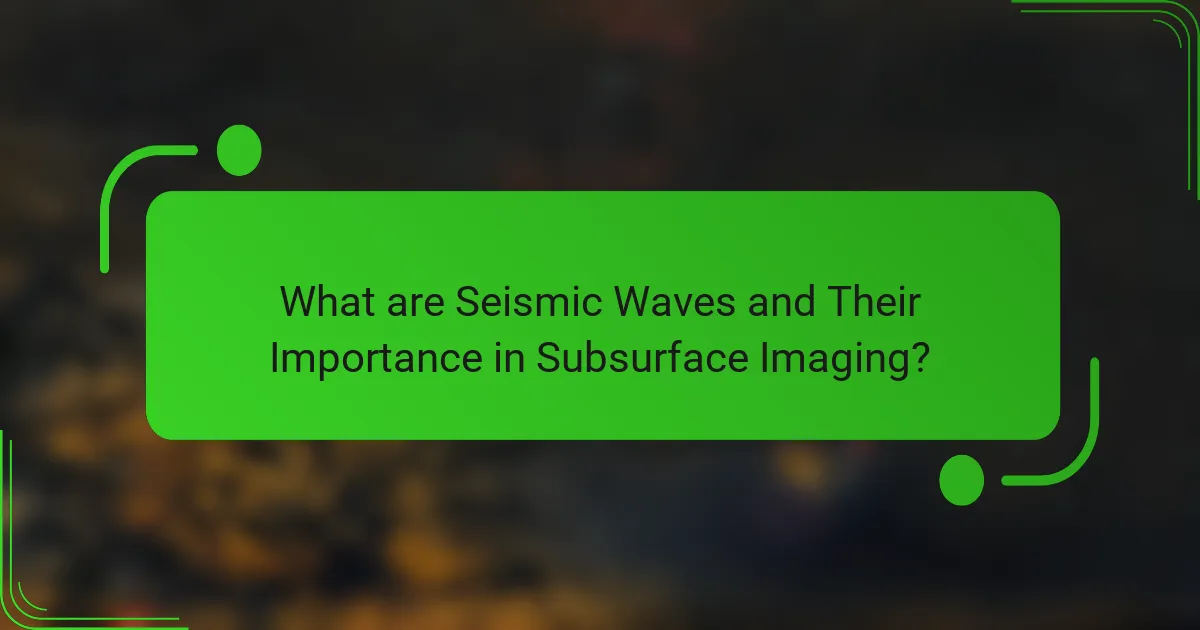
What are Seismic Waves and Their Importance in Subsurface Imaging?
Seismic waves are elastic waves generated by the sudden release of energy in the Earth’s crust. They travel through the Earth and can be classified into two main types: body waves and surface waves. Body waves include P-waves, which are primary waves that compress and expand material, and S-waves, which are secondary waves that shear material. Surface waves travel along the Earth’s surface and typically cause more damage during seismic events.
In subsurface imaging, seismic waves are crucial for understanding geological structures and resources. They help geophysicists locate oil, gas, and mineral deposits. Seismic surveys use these waves to create images of the subsurface by analyzing wave reflections and refractions. This technique provides valuable information about the composition and behavior of subsurface materials.
The importance of seismic waves in subsurface imaging is underscored by their ability to reveal intricate details of geological formations. For instance, seismic data can identify fault lines and stratigraphy, which are essential for resource extraction and hazard assessment. Advanced technologies, such as 3D seismic imaging, enhance the clarity and accuracy of subsurface maps, facilitating better decision-making in exploration and development.
How do seismic waves generate and propagate through different geological layers?
Seismic waves are generated by the sudden release of energy in the Earth’s crust, typically due to tectonic activity or human-made explosions. These waves travel through different geological layers by interacting with the material properties of those layers. As seismic waves encounter variations in density and elasticity, they change speed and direction. Primary waves (P-waves) travel faster and can move through solids and liquids, while secondary waves (S-waves) only propagate through solids.
In sedimentary layers, seismic waves may be reflected or refracted, depending on the layer’s composition. Denser materials tend to slow down the wave speed, while less dense materials allow faster propagation. Studies show that the speed of seismic waves varies significantly between different geological materials, such as granite and sedimentary rock. This variability helps geophysicists interpret subsurface structures and identify resources.
Thus, understanding the generation and propagation of seismic waves through geological layers is crucial for effective subsurface imaging and resource exploration.
What types of seismic waves exist and what are their characteristics?
There are two main types of seismic waves: body waves and surface waves. Body waves travel through the Earth’s interior, while surface waves travel along the Earth’s surface.
Body waves are further divided into two categories: primary waves (P-waves) and secondary waves (S-waves). P-waves are compressional waves that move in the same direction as the wave, allowing them to travel through solids, liquids, and gases. They are the fastest seismic waves, arriving first at seismic recording stations.
S-waves, on the other hand, are shear waves that move perpendicular to the wave direction. They can only travel through solids, making them slower than P-waves. S-waves arrive after P-waves at seismic stations.
Surface waves consist of Love waves and Rayleigh waves. Love waves move horizontally and cause horizontal shaking, while Rayleigh waves create an elliptical motion, leading to both vertical and horizontal ground movement. Surface waves are generally slower than body waves and cause the most damage during earthquakes.
These characteristics of seismic waves are crucial for understanding earthquake dynamics and subsurface imaging techniques.
How do seismic wave properties influence subsurface imaging quality?
Seismic wave properties significantly influence subsurface imaging quality. The velocity, frequency, and amplitude of seismic waves determine how well subsurface structures can be identified. Higher frequency waves provide better resolution but have limited [censured] depth. Conversely, lower frequency waves penetrate deeper but offer lower resolution. Wave propagation characteristics, such as attenuation and scattering, also affect imaging clarity. For instance, attenuation reduces wave energy, leading to weaker signals and poorer images. Scattering can distort wave paths, complicating the interpretation of subsurface features. Accurate modeling of these properties enhances the effectiveness of imaging techniques, such as seismic reflection and refraction methods. Studies show that optimizing wave properties improves subsurface image quality, facilitating better geological assessments.
Why are seismic waves critical for understanding subsurface structures?
Seismic waves are critical for understanding subsurface structures because they provide insights into the Earth’s internal composition. These waves travel through various geological materials and reflect or refract at boundaries, revealing information about layers. By analyzing the time it takes for seismic waves to travel and return, geologists can infer the depth and type of subsurface formations.
Seismic data allows for the identification of resources like oil, gas, and minerals. It also aids in assessing geological hazards such as earthquakes and landslides. The use of seismic waves in techniques like reflection and refraction seismology enhances the accuracy of subsurface imaging.
Studies show that seismic imaging has a high resolution, enabling detailed mapping of complex geological structures. For instance, the ability to distinguish between sedimentary layers and fault lines is crucial for engineering and environmental assessments. Therefore, seismic waves are essential tools for geoscientists in understanding and interpreting subsurface conditions.
What role do seismic waves play in resource exploration?
Seismic waves are crucial in resource exploration as they help map subsurface structures. These waves travel through the Earth and reflect off different geological layers. By analyzing the reflected waves, geologists can identify the location and characteristics of resources like oil, gas, and minerals. This method is known as seismic surveying. It provides detailed images of the subsurface, allowing for more accurate drilling locations. According to the American Association of Petroleum Geologists, seismic data significantly reduces exploration risks. This technology has been used for decades and continues to evolve, enhancing resource discovery and extraction efficiency.
How do seismic waves enhance geological hazard assessments?
Seismic waves enhance geological hazard assessments by providing critical information about subsurface structures. They allow scientists to analyze the properties and behaviors of geological formations. This analysis helps identify potential hazards such as earthquakes and landslides. Seismic waves can reveal faults, fractures, and other geological features. These insights enable better risk evaluation and mitigation strategies. For instance, studies show that seismic data improves earthquake prediction models. Enhanced assessments lead to more informed urban planning and construction practices. This ultimately reduces the impact of geological hazards on communities.
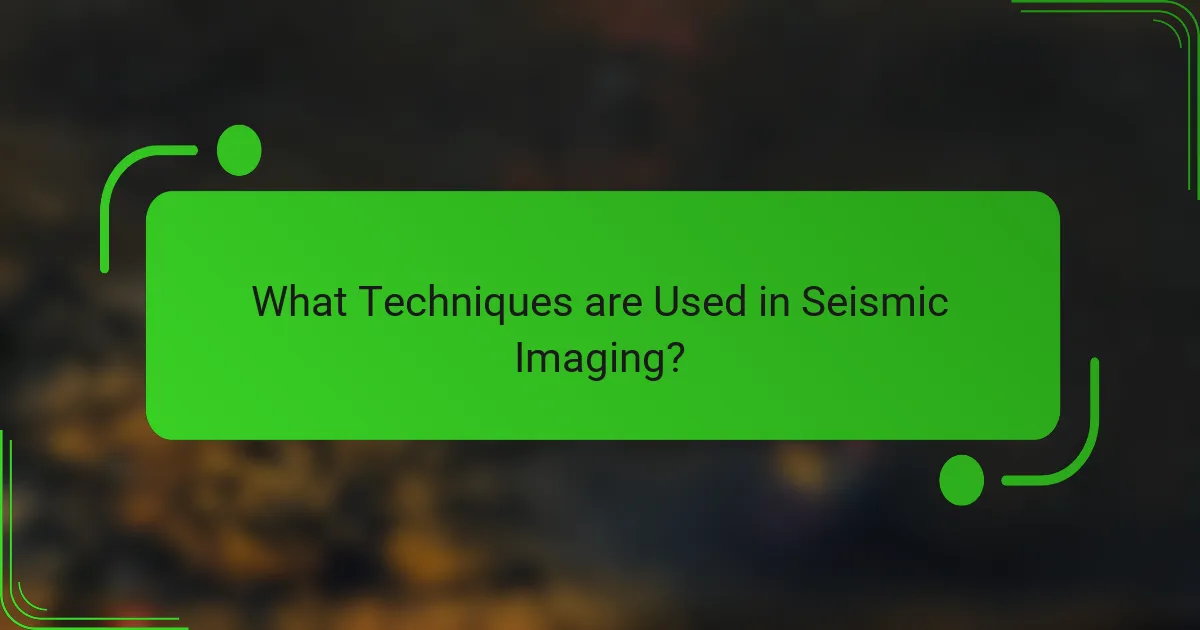
What Techniques are Used in Seismic Imaging?
Seismic imaging techniques include reflection seismology, refraction seismology, and seismic tomography. Reflection seismology uses seismic waves that reflect off subsurface structures. This technique helps in mapping geological layers and locating resources. Refraction seismology measures the bending of seismic waves as they pass through different materials. It is effective for determining subsurface velocities and layers. Seismic tomography involves creating three-dimensional images of the subsurface using seismic data. This technique enhances the understanding of complex geological structures. Each method relies on analyzing wave propagation and interaction with geological features. These techniques are essential in oil and gas exploration, earthquake studies, and environmental assessments.
How does reflection seismology work?
Reflection seismology works by sending seismic waves into the ground and analyzing their reflections. Seismic waves are generated by a source, such as a hammer or explosive charge. These waves travel through different subsurface layers and reflect back to the surface when they encounter a boundary between materials. Sensors, called geophones, detect the reflected waves. The time it takes for the waves to return is measured and used to determine the depth and characteristics of subsurface layers. This method helps in identifying geological formations and resources like oil and gas. Reflection seismology is widely used in the oil and gas industry for exploration and in civil engineering for site assessments.
What are the key components of reflection seismology systems?
The key components of reflection seismology systems include energy sources, geophones, data acquisition systems, and processing software. Energy sources generate seismic waves, which can be explosives or vibroseis trucks. Geophones detect the reflected seismic waves from subsurface structures. Data acquisition systems record the signals captured by geophones. Processing software analyzes the data to create subsurface images. These components work together to provide detailed information about geological formations. Each component plays a crucial role in the accuracy and effectiveness of subsurface imaging.
How does data interpretation occur in reflection seismology?
Data interpretation in reflection seismology involves analyzing seismic wave data to identify subsurface structures. This process begins with the collection of seismic data through controlled seismic wave generation. The reflected waves are recorded by geophones, which convert them into electrical signals. These signals are then processed to create seismic profiles.
Interpretation occurs by examining these profiles for patterns and anomalies. Geologists and geophysicists use various techniques, including amplitude analysis and time-depth conversion. They correlate the seismic data with known geological formations to enhance accuracy.
The interpretation also relies on software tools for modeling and visualization. These tools help in understanding the geometry and composition of subsurface features. Ultimately, the accuracy of interpretation is validated through cross-referencing with borehole data and geological surveys.
What is the significance of refraction techniques in seismic imaging?
Refraction techniques are significant in seismic imaging as they enhance the understanding of subsurface structures. These techniques utilize the bending of seismic waves at interfaces between different geological layers. By analyzing the travel times of refracted waves, geophysicists can infer the depth and shape of subsurface formations. This method is particularly effective in mapping shallow geological features. It provides valuable data for resource exploration, including oil and gas. Refraction techniques also improve the accuracy of geological models. Studies show that they can reduce uncertainty in subsurface characterization. Overall, they play a crucial role in optimizing seismic surveys and interpretations.
How do refraction methods differ from reflection methods?
Refraction methods differ from reflection methods in how they utilize seismic waves. Refraction methods analyze waves that travel through different layers of the earth, bending at layer boundaries. This bending occurs due to changes in material properties, such as density and elasticity. In contrast, reflection methods focus on waves that bounce off subsurface structures and return to the surface. Reflection occurs at interfaces where there is a significant contrast in acoustic impedance.
Refraction is effective for mapping shallow subsurface features, while reflection is better for deeper geological structures. Refraction methods often require fewer sensors and can cover larger areas quickly. Reflection methods typically provide higher resolution images of subsurface structures. These differences make each method suitable for specific geological investigations.
What are the advantages of using refraction techniques?
Refraction techniques offer several advantages in seismic imaging. They provide accurate depth estimation of subsurface layers. This method is effective in identifying geological structures. Refraction techniques are also cost-efficient compared to other seismic methods. They require less equipment and personnel for data collection. Additionally, these techniques can be applied in various terrains, including urban areas. They produce clear and interpretable data for geologists and engineers. Overall, refraction techniques enhance the understanding of subsurface conditions efficiently.
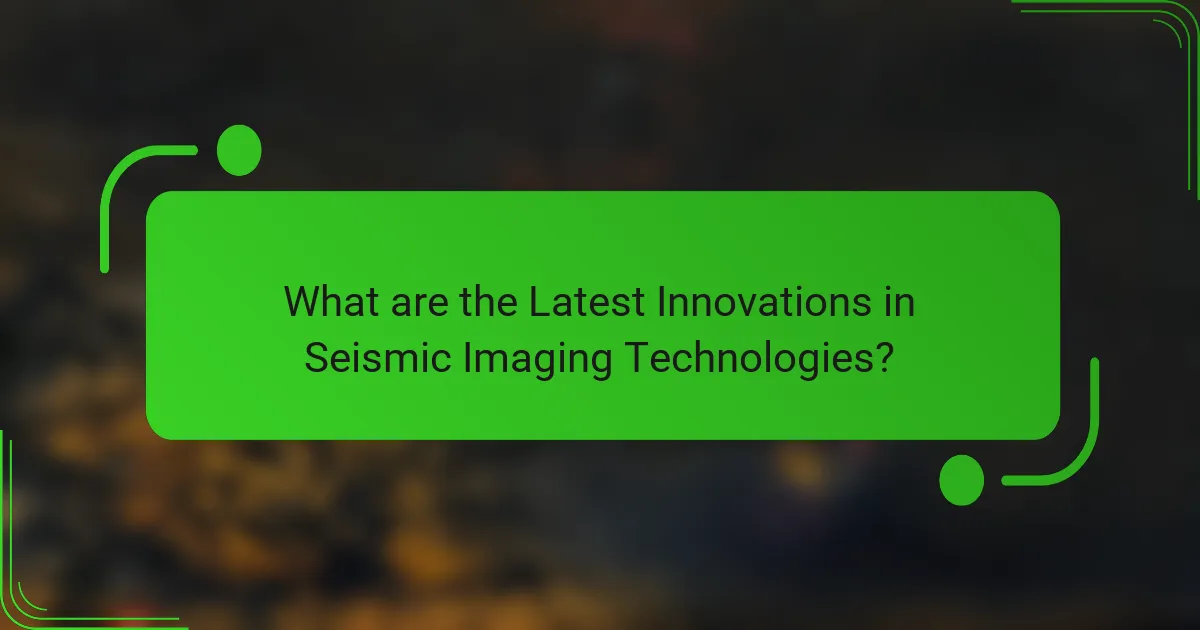
What are the Latest Innovations in Seismic Imaging Technologies?
The latest innovations in seismic imaging technologies include advancements in machine learning and artificial intelligence. These technologies enhance the interpretation of seismic data, improving accuracy and speed. Additionally, 4D seismic monitoring allows for real-time observation of subsurface changes. This technique is crucial in reservoir management and monitoring environmental impacts. Another innovation is the use of fiber-optic sensing, which provides high-resolution data over large areas. This method reduces costs and increases data collection efficiency. Furthermore, integrated geophysical methods combine seismic data with other geospatial data for better subsurface modeling. These innovations collectively enhance exploration and monitoring capabilities in various industries.
How have advancements in technology improved seismic data acquisition?
Advancements in technology have significantly improved seismic data acquisition by enhancing data collection methods and processing capabilities. Modern sensors, such as broadband seismometers, provide higher resolution and sensitivity. These sensors can detect a wider range of seismic frequencies, allowing for more detailed subsurface imaging. Additionally, advancements in data processing algorithms enable faster and more accurate interpretation of seismic data. Techniques like machine learning are increasingly applied to analyze large datasets efficiently. Furthermore, the integration of remote sensing technologies has expanded the reach and effectiveness of seismic surveys. This combination of improved hardware and software leads to more reliable and comprehensive seismic data acquisition.
What role do digital sensors play in modern seismic imaging?
Digital sensors are crucial in modern seismic imaging. They capture seismic waves generated by natural or artificial sources. These sensors convert physical vibrations into electronic signals for analysis. High-resolution data from digital sensors enhances the accuracy of subsurface imaging. They enable real-time monitoring of seismic events and subsurface conditions. Advanced digital sensors can detect a wide frequency range. This capability improves the interpretation of geological structures. Research indicates that digital sensors significantly increase data quality and processing speed.
How has machine learning transformed seismic data processing?
Machine learning has significantly transformed seismic data processing by enhancing data interpretation and analysis. Traditional methods often struggled with the complexity and volume of seismic data. Machine learning algorithms can analyze vast datasets quickly and accurately. They identify patterns and anomalies that may be missed by human analysts. For instance, convolutional neural networks (CNNs) have been used to improve fault detection in seismic images. A study published in the journal “Nature” demonstrated that machine learning models could reduce interpretation time by up to 70%. Additionally, these models improve the accuracy of subsurface models, leading to better resource exploration and management. Overall, machine learning techniques have streamlined seismic data workflows, making them more efficient and reliable.
What emerging trends are shaping the future of seismic imaging?
Emerging trends shaping the future of seismic imaging include the integration of artificial intelligence and machine learning. These technologies enhance data processing and interpretation efficiency. Advanced algorithms can analyze vast datasets quickly, improving accuracy in subsurface mapping. Additionally, the use of cloud computing allows for scalable data storage and access. This facilitates real-time collaboration among geoscientists. Another trend is the adoption of 4D seismic imaging, which monitors changes over time. This technique provides insights into reservoir dynamics and aids in resource management. Furthermore, miniaturized sensors and drones are becoming common for data collection. These innovations improve accessibility and reduce costs in seismic surveys. Collectively, these trends are revolutionizing the field of seismic imaging.
How do integrated geophysical methods enhance subsurface imaging?
Integrated geophysical methods enhance subsurface imaging by combining multiple data acquisition techniques. These methods include seismic, electromagnetic, and gravity surveys. The integration improves the resolution and accuracy of subsurface models. For instance, seismic data provides information on structural features, while electromagnetic methods reveal material properties. This multi-faceted approach allows for better identification of geological formations. Studies show that integrated methods can reduce uncertainty in subsurface interpretations. Enhanced imaging is crucial for applications in resource exploration and environmental assessments. Therefore, the synergy of different geophysical techniques leads to more reliable subsurface insights.
What potential does artificial intelligence hold for seismic wave analysis?
Artificial intelligence holds significant potential for seismic wave analysis. AI can enhance the interpretation of seismic data through advanced machine learning algorithms. These algorithms can identify patterns and anomalies in large datasets more efficiently than traditional methods. AI can also automate the classification of seismic events, reducing the time required for analysis. Research indicates that AI applications in this field can improve the accuracy of subsurface imaging. A study published in the journal “Geophysics” found that AI techniques increased the detection rate of seismic events by over 30%. Additionally, AI can facilitate real-time monitoring of seismic activity, providing timely data for emergency response.
What Best Practices Should Be Followed in Seismic Imaging?
Best practices in seismic imaging include careful planning and data acquisition. Accurate survey design is essential for effective data collection. Utilize appropriate seismic sources and receivers for the specific geological context. Ensure high-quality data processing techniques are applied. This includes noise reduction and proper migration algorithms. Regular calibration of equipment enhances data reliability. Implement thorough quality control measures throughout the process. Continuous training for personnel ensures adherence to industry standards. These practices lead to improved imaging results and more reliable interpretations.
How can data quality be maximized during seismic surveys?
Data quality can be maximized during seismic surveys by implementing rigorous data acquisition protocols. Proper calibration of seismic instruments ensures accurate measurements. Utilizing advanced data processing techniques enhances signal clarity. Regular equipment maintenance minimizes errors due to faulty instruments. Employing appropriate survey design optimizes data collection efficiency. Training personnel in best practices reduces human error. Continuous monitoring of environmental conditions mitigates external noise interference. These methods collectively improve the reliability and accuracy of seismic data.
What common challenges should practitioners be aware of when using seismic waves for subsurface imaging?
Practitioners using seismic waves for subsurface imaging face several common challenges. One challenge is the complexity of wave propagation in different geological materials. Variations in density and elasticity can distort seismic waves. Another challenge is the presence of noise, which can interfere with signal clarity. Environmental factors, such as weather conditions, also impact data quality. Additionally, interpreting seismic data can be complicated by the presence of multiple reflections. Practitioners must also manage the limitations of resolution in deeper layers. Finally, equipment calibration and maintenance are crucial for accurate results. These challenges necessitate careful planning and execution in seismic imaging projects.
Seismic waves are elastic waves produced by energy release in the Earth’s crust, essential for subsurface imaging. This article explores the types of seismic waves, their propagation through geological layers, and their critical role in identifying resources and assessing geological hazards. It covers various seismic imaging techniques, including reflection and refraction methods, and highlights the latest innovations in technology, such as machine learning and integrated geophysical methods. Additionally, best practices for maximizing data quality during seismic surveys and common challenges faced by practitioners are discussed, providing a comprehensive understanding of the significance of seismic waves in subsurface exploration.
